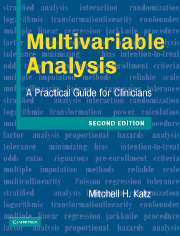Book contents
- Frontmatter
- Contents
- Preface
- 1 Introduction
- 2 Common uses of multivariable models
- 3 Outcome variables in multivariable analysis
- 4 Type of independent variables in multivariable analysis
- 5 Assumptions of multiple linear regression, multiple logistic regression, and proportional hazards analysis
- 6 Relationship of independent variables to one another
- 7 Setting up a multivariable analysis
- 8 Performing the analysis
- 9 Interpreting the analysis
- 10 Checking the assumptions of the analysis
- 11 Propensity scores
- 12 Correlated observations
- 13 Validation of models
- 14 Special topics
- 15 Publishing your study
- 16 Summary: Steps for constructing a multivariable model
- Index
10 - Checking the assumptions of the analysis
Published online by Cambridge University Press: 05 July 2011
- Frontmatter
- Contents
- Preface
- 1 Introduction
- 2 Common uses of multivariable models
- 3 Outcome variables in multivariable analysis
- 4 Type of independent variables in multivariable analysis
- 5 Assumptions of multiple linear regression, multiple logistic regression, and proportional hazards analysis
- 6 Relationship of independent variables to one another
- 7 Setting up a multivariable analysis
- 8 Performing the analysis
- 9 Interpreting the analysis
- 10 Checking the assumptions of the analysis
- 11 Propensity scores
- 12 Correlated observations
- 13 Validation of models
- 14 Special topics
- 15 Publishing your study
- 16 Summary: Steps for constructing a multivariable model
- Index
Summary
How do I know if my data fit the assumptions of my multivariable model?
In Chapter 5, we reviewed the ways to assess, in bivariate analysis, whether the relationship between a single independent variable and outcome fit the assumptions of your model. In this chapter, we will review how to assess whether these assumptions are fulfilled on a multivariable level.
For didactic purposes, I have separated the discussion of whether your data fit the assumptions of your model from the discussion of how well your model accounts for the outcome (Section 9.2). But, in fact, these two topics are closely related. In a model where your independent variables closely account for your outcome, it is likely that your data fit the assumptions of your model. Conversely, if your model does not appear to fit your observed outcome, the reason might be that your data do not fit the assumptions of the model. When this is the case, adding, deleting, or transforming variables may improve the fit of your model. Part of why I separated the discussion of these two issues is that most researchers will interpret their multivariable printouts, make changes, and add or delete variables before going on to verify the assumptions of their final model.
Residual analysis is a helpful tool for assessing whether your data fit the assumptions of your multivariable model. Residuals are the difference between the observed and the estimated value.
Information
- Type
- Chapter
- Information
- Multivariable AnalysisA Practical Guide for Clinicians, pp. 137 - 152Publisher: Cambridge University PressPrint publication year: 2006
Accessibility standard: Unknown
Why this information is here
This section outlines the accessibility features of this content - including support for screen readers, full keyboard navigation and high-contrast display options. This may not be relevant for you.Accessibility Information
- 1
- Cited by
